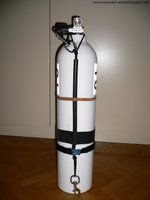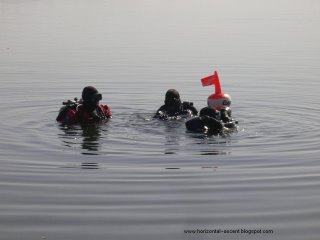
1) This gas was introduced in an effort to overcome the inability of
unqualified student "tech" divers to control their buoyancy in open
water, and is as such is yet one more concession to doing things in a
convoluted fashion to offset a self- inflicted set of problems brought
on by the "doing it wrong" thinking that pervades diving today.
2) A heavy sea is not a problem for a deco stop if it is not posing a
lung-loading problem. Look at your depth guage in a heavy sea and "see"
for yourself what the changes are - insignificant, and if they are not,
you should either not have been diving or incurring a decompression
liability of this magnitude in the first place. In the event of a change
in conditions during the dive, see below where the 80/20 becomes a
liability rather than an assett.
3) In the interest of using a standardized set of gases for which you
can permanently mark your bottles , it is a poor concession to inability
to sacrifice the benfits of pure O2 to accomodate a real or percived
lack of skill - learn to dive before taking up techdiving.
4) In this same interest you will find that when you graduate to real
diving, as in caves, you will not want to accellerate your ppo2 at
lower depths while still being faced with a long decompression at
shallower depths, and making bizarre mixes to do this is a dangerous
mistake (just like the fantasy of holding an accellerated ppo2 on a
rebreather throughout a deco). I am anticipating the thinking that the
80/20 crowd would then go to an additional oxygen in cave without
accounting for total exposure, and subject themselves to the risk of tox
in the final deco steps. Tox you do not get out of - bends you do.
5) The 80/20 mix is in fact totally useless and contraindicated as a
deco gas. At thirty feet it is only a 1.52 ppo2 ( the real 1.6 ppo2
gas would be 84/16) and as such does not either provide the right
oxygen window, nor does it does it work as well as pure oxygen without
an inert gas at any depth. The gas mixing in your lungs has already
lowerd the effective ppo2 enough to prevent spiking at 20 feet anyway
with the use of pure oxygen - in other words, we aer dealing with a
simplisitc misunderstanding here, or "old wives tale" that is typical in
diving.

6) If 100% oxygen is a percieved buoyancy control risk at 20 feet, then
why is the same ppo2 ( intended) not a risk at 30 feet? This shows the
total lack of reasonable logic involved in the decision to use this gas,
as well as a lack of understanding of the whole picture ( see the rest
of this discussion).
7) Along those lines, all we hear is howling about "oxygen cleaning"
above 40% mixtures, and dive shop proprietors on here complaining about
scuba tanks with oxygen in them being filled in their shops. With a
pure oxygen system, the tank only ever gets filled with oxygen from
oxygen tanks, not from every dive shop compressor it sees. Again , this
shows the total inconsistency of agency thinking, and reveals that the
true reason for this gas is to pretend to lower liability for teaching
incompetents to dive, which is bull, and to attempt to accrue some
inventive accomplishemts to the dive agency pundits who themseleves
prove that they do no real diving by making this recommendation
in the first place. This is like the colored regs, the stages on either
side, the quick-release buckle, and the poodle jacket: nonsense of the
most obvious nature developped through one-dimesional thinking by those
whose universe of understanding is not only severly limited, but blinded
by the hubris of not being the "inventor" of the techniques that work.
8) Any perceived decompression benefit of using a higher ppo2 at 30
feet with 80/20 is then given back by the lowered ppo2 at 20 feet, not
to mention the fact that the presence of the inert gas in the breathing
mixture defeats the purpose of using oxygen in the first place ( see
the Physiology and Medicine of Diving) . The ppo2 of 80/20 at 20 feet
is 1.28, not much of an oxygen window, and at 10 feet it is 1.04 -
useless for deco. To make matters worse, you can not get out from your
30 foot stop in an emergency ( not doing the other stops) on the 80/20
mix without really risking a type 2 hit.
9) This is a dangerous method to achieve a greater total volume of gas
for the bad breathers (another obvious reason the gas is in vogue), who
should not be incurring these decos, and even that benefit of having
more gas is lost since it is breathed at 30 feet, and then has to last
for the other stops. The fact is that gas is effecively saved by using
the lower deco gas up to this point, relying on the pressure gradient
to both achieve the deco and provide a break from high the previous
gas's higher PPO2 prior to going to pure oxygen where the spike could
be a problem on an extreme exposure without an adequate low ppo2 break (
again this shows that the 80% user is a neopyte diver with no real
experience or understanding of the true risks of these dives) .
10) The 20-30% longer 30 foot time on the lower ppo2 is not only
overcome on the pure oxygen at the next stops, the breaks do not come
into play until the initial good dose of pure oxygen has been absorbed,
since you are not spiking from a high pervious dose without a break
that is effectively achieved on the previous gas. These things need to
be understood and taught by the agencies, not some superficial
convolution that is designed to obfuscate the problem rather than
openly acknowledge and deal with it in a responsible fashion.
11) In an emergency situation, getting onto the pure O2 for 20 minutes
or so (for long dives something approximating the bottom time or a any
decent interval) would give you a real good shot at getting out of
the water having missed the rest of your deco and living through it
with pain hits only. You have to think these things all the way though,
not go for the transparent superficial thinking of those who merely are
trying to "make their mark" with some "great" idea they can call their
own. The acid test is , as always, is the caliber of the divers who
adopt these practices.
12) If there is some problem with your deco or you otherwise develop
symptoms and need oxygen either on the surface or back in the water, it
is silly to have not had it there all along. 80/20 is a joke for that
purpose, unless you have asthma, in which case any accellerated oxygen
mix would be a nightmare. This is again part of the "thinking it all the
way through" phiosophy which is obviously mising from the 80/20
argument.
13) Only a card-carrying stroke would do somethng like this, and
showing up with 80/20 is no different than wearing a sign on your back
saying "I am a stroke, and have the papers to prove it". It announces to
all the world that you have no clue, kind of like wearing clip-on
suspenders or having dog dirt on your shoes.
Fonte articolo:
Divetek adventuresFoto sopra: painterskeys.com





 Preparazione
Preparazione






